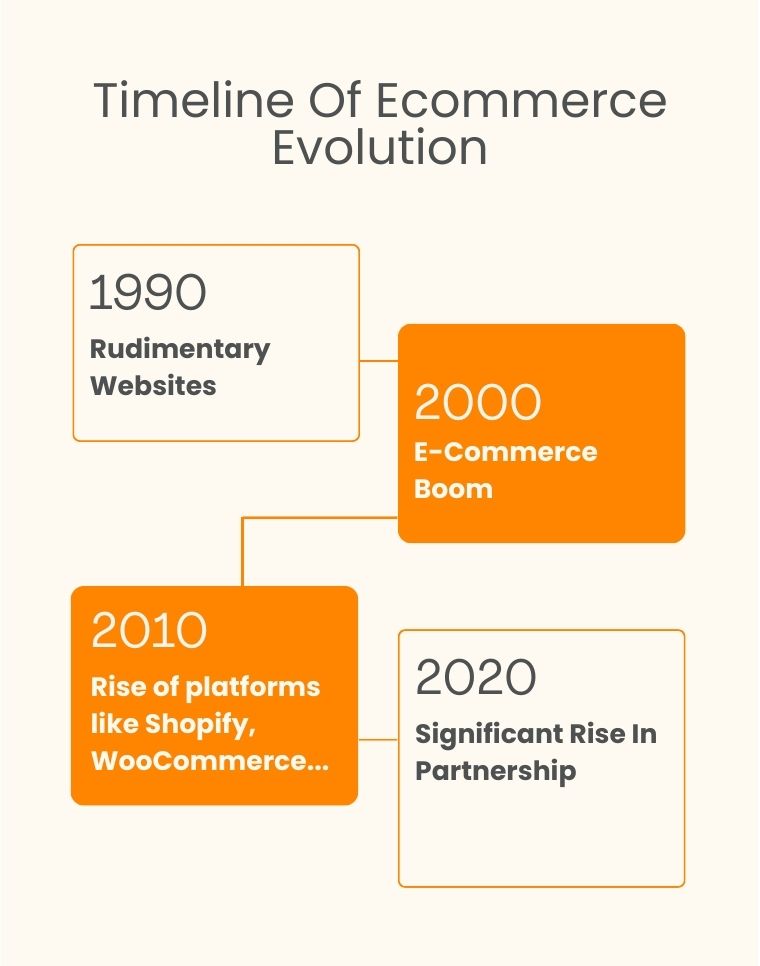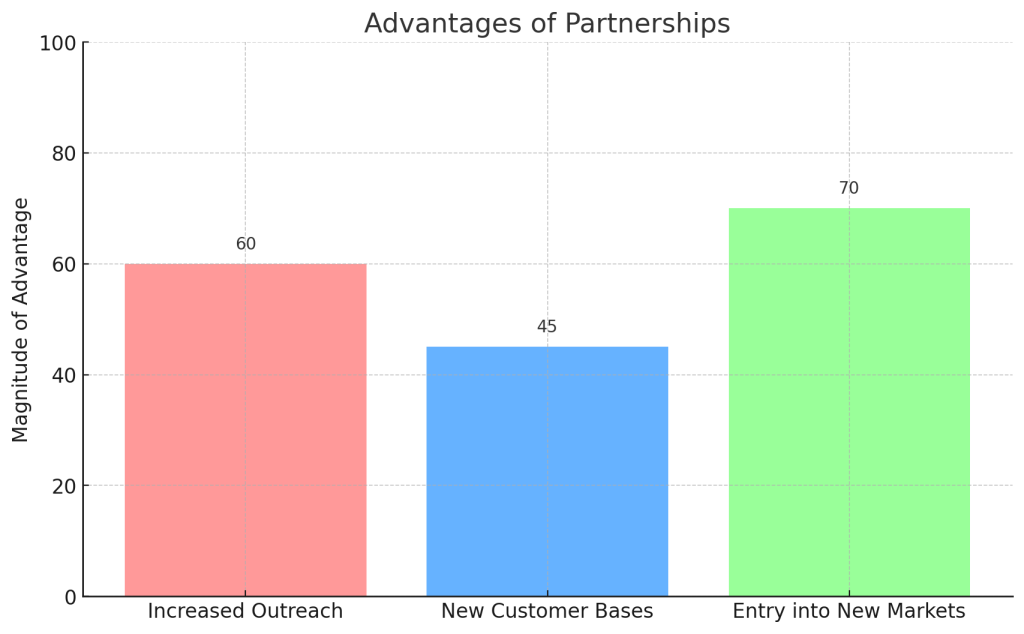Overcoming E-Commerce Partnership Challenges
Category partnerships

Posted by Wei T.
Growth Marketing Expert

Introduction
In the rapidly evolving world of e-commerce, no brand is an island. The digital marketplace's landscape has seen significant shifts, with one particularly notable trend being the rise of partnerships.
These alliances, ranging from collaborations between industry giants to smaller scale tactical team-ups, have proven to be essential game-changers.
A. The E-commerce Evolution and the Emergence of Partnerships

From its modest beginnings in the early '90s, when rudimentary websites sold books and music, e-commerce has come a long way.
Today, with platforms like Shopify, WooCommerce, and Magento paving the way, it's easier than ever to set up shop online. Yet, while the tools are accessible, the competition is fiercer than ever.
In this densely populated e-marketplace, partnerships have emerged as a strategy to cut through the noise.
Two entities combining their strengths, audiences, and expertise can often reach greater heights than they might have achieved independently.
B. Scaling and Broadening Horizons Through Partnerships
Brands, both big and small, have discovered the magic formula. By joining forces, they can effectively double their outreach, tap into new customer bases, and even venture into markets previously deemed out of reach.
Such partnerships are not just about sharing resources; they're about creating a synergy where the combined efforts surpass the sum of individual attempts.
 Here's the Bar Chart of Partnership Benefits, highlighting the magnitude of advantages that partnerships can offer in various domains.
Here's the Bar Chart of Partnership Benefits, highlighting the magnitude of advantages that partnerships can offer in various domains.
For example, when a local e-commerce brand partners with an international shipping provider, they're not just accessing logistics.
They're breaking into international markets, gaining global exposure, and often, achieving a significant increase in sales.
C. The Imperative of Addressing Partnership Challenges
However, as with any alliance, e-commerce partnerships come with their fair share of challenges.
From aligning branding messages to synchronizing backend operations, these challenges can make or break the union. Recognizing and proactively addressing these obstacles is crucial for a thriving and successful e-commerce venture.
II. Partnership Challenge 1: Aligning with a Partner's USP

In a world where every brand strives to stand out, each comes with its Unique Selling Proposition (USP) - a factor that differentiates it from the competition. When two brands form an alliance, aligning these USPs becomes paramount.
A. Mutual Understanding and Complementing USPs
In a partnership, understanding and respecting each entity's USP is fundamental. It's not just about blending two brands; it's about creating a partnership where both brands amplify each other.
For example, a premium e-commerce brand that boasts exclusive products might partner with a delivery service known for its speedy and premium handling.
The two USPs, when combined, promise customers high-quality products delivered quickly.
B. The Apple-Android Dichotomy
A classic example of contrasting USPs is the age-old Apple vs. Android debate.
While Apple's ecosystem boasts privacy, exclusivity, and a seamless user experience, Android champions affordability, customization, and open-source flexibility.
Imagine a scenario where these two giants decided to collaborate on a project. Finding a middle ground would be essential, such as creating a product that offers enhanced privacy features (from Apple's USP) at a more accessible price point (from Android's USP).
C. Crafting a Collaborative Strategy
When two brands decide to partner, the shared strategy should accentuate both partners' strengths.
This might involve brainstorming sessions, workshops, and a lot of research to identify the sweet spot where both USPs can shine.
It's about creating an offer that customers from both brands would find irresistible.
D. Research, Competitor Analysis, and Feedback: The Path to Synergy
To align USPs effectively:
- Research the market: Understand current trends and see how both USPs can tap into them.
- Competitor analysis: Identify what competitors are doing and find gaps that the partnership can fill.
- Customer feedback: Existing customers are gold mines of information. Gather feedback to understand what they would value most from such a collaboration.
By following these steps and leveraging tools designed for e-commerce analysis, brands can ensure their partnership thrives, driving mutual growth and delivering unmatched value to their customers.
III. Partnership Challenge 2: Coordinated Lead Generation

Effective lead generation is the lifeline of any e-commerce business. When two entities partner, aligning their lead generation strategies becomes essential to avoid conflicting messages and to maximize outreach.
A. Harmonizing Lead Generation Between Partners
Just as an orchestra requires each instrument to play in harmony, e-commerce partnerships require each brand to coordinate their lead generation efforts. The aim is to amplify, not overlap or compete. A disjointed approach can confuse potential customers, diluting the partnership's impact.
B. Merging Distinct Strategies
Each brand enters a partnership with its established strategies. If Partner A has always found success with Google ads, while Partner B has an engaged audience on Facebook, it's about combining these strengths.
Joint campaigns, where each brand taps into its preferred platform while promoting both entities, can significantly widen the reach.
For more on how partnerships can work seamlessly, check out Business Partnerships: The Power of Collaboration.
C. Diversifying Together
Joint webinars, co-hosted podcasts, or educational content leveraging the expertise of both brands can be powerful tools.
Such initiatives not only attract a broader audience but also establish the partnership's authority.
👉 Dive deeper into the nuances of online partnership marketing with this article.
D. Co-branded Content for Mutual Benefit
Creating content that carries the branding of both partners can be a win-win. It can be anything from blog posts, videos, to infographics.
For a comprehensive understanding of how to forge successful partnerships, take a look at How to Create Partnerships.
E. Expanding Outreach Through Shared Media

A combined effort in building and leveraging email lists can result in a much wider outreach.
Imagine an exclusive offer promoted through a co-branded email campaign; subscribers from both brands get access, effectively doubling the potential audience.
Furthermore, by sharing media resources, partners can reduce costs while still achieving or even surpassing their marketing goals.
For more strategies on expanding sales through partnerships, explore Automated Cross-selling to Boost Sales.
IV. Partnership Challenge 3: Ensuring Website Consistency
In the digital age, a brand's website is its storefront. When brands partner, ensuring website consistency becomes crucial. A cohesive user experience fosters trust and streamlines the customer journey.
A. Presenting a Unified Branding Front
Customers should feel a sense of unity when navigating either partner's website. Disjointed branding or contrasting user experiences can be off-putting. It's essential that partners agree on design elements, branding guidelines, and user experience pillars to present a unified front.
B. Synchronized Product Descriptions and Branding
Imagine a product co-developed by two brands. If it's presented differently on each partner's website, it can cause confusion. Aligning product descriptions, images, pricing, and branding ensures customers receive consistent information, irrespective of where they're shopping.
C. Embracing Shared Analytics
Knowledge is power. By sharing website analytics, partners can gain insights into collective audience behavior. Understanding which products are popular, where customers tend to drop off, and their preferences can guide future strategies. Tools like Google Analytics can be instrumental in this collaborative analysis.
D. Joint Decision-making Based on Collective Insights
After gleaning insights from shared analytics, it's essential that any changes or updates to the websites are coordinated. If analytics show that a specific product is popular, both partners could decide to offer a discount, bundle it with other products, or even feature it prominently on their homepages.
IV. Partnership Challenge 4: Integrating Products and Systems
In a world driven by technology, the way partners integrate their products and systems can significantly influence the success of their collaborative endeavors. A smooth technical integration ensures that both brands amplify each other's strengths without hindering the customer experience.
A. The Seamless Integration Imperative
When two e-commerce entities decide to partner, their technological platforms must communicate flawlessly. This is not just about APIs or data exchange; it's about offering the customer a consistent and enhanced shopping journey. Understand more about the importance of partnerships in Business Partnerships: The Power of Collaboration.
B. Choosing Partnership-friendly Software
Both partners should be willing to adopt systems that facilitate easier integration. This may mean choosing software designed with partnerships in mind or systems that are widely recognized for their interoperability. Delve deeper into the tools that can enhance partnerships with E-commerce Partnership Tools to Boost Sales.
C. Utilizing Integration Platforms
Shared tools like Zapier or even custom-built integration platforms can streamline operations, ensuring that both partners are on the same page. These tools help synchronize inventory, pricing, customer data, and more. Learn more about optimizing costs through Partnership Tools to Cut Marketing Costs.
D. Collaborative Data Flow and Problem Solving
With integrated systems, data exchange becomes a regular phenomenon. This shared data should be utilized collaboratively to solve challenges, be they operational glitches or customer grievances.
VI. Partnership Challenge 5: Offering a Unified Customer Experience
A partnership, while being a union of two brands, should appear as a singular entity to the customer, offering them a seamless experience regardless of which brand they interact with directly.
A. Shared Responsibility in Customer Retention
Both brands have the joint task of retaining and satisfying customers. The synergy of two brands can often lead to a more enriched customer experience. Dive into the intricacies of collaborations through How to Create Partnerships.
B. Seamless Customer Service Across Platforms
Whether it's a query, a grievance, or a simple inquiry, the response's quality and speed should be consistent across both brands. It reinforces trust and assures customers of the partnership's strength.
C. Collaborative Loyalty Programs and Promotions
Imagine earning points on Brand A and redeeming them on Brand B. Joint loyalty initiatives like these not only delight customers but also encourage them to engage with both brands. For more on increasing sales through collaborations, explore Automated Cross-selling to Boost Sales.
D. Coordinated Social Media Efforts
Unified branding messages, joint campaigns, and mutual promotions on platforms like Instagram, Facebook, and Twitter can magnify the partnership's reach.
Get deeper insights on leveraging digital platforms in partnerships with Trends in E-commerce Partnership Marketing.
VII. Partnership Challenge 6: Harmonizing Return and Refund Policies
Every e-commerce venture understands the importance of a clear and efficient return and refund policy. However, when two brands join hands, aligning these policies can be challenging, yet essential.
A. Acknowledging the Differences
First and foremost, both partners need to understand and respect the nuances in their respective return policies.
The key lies in open dialogue, where partners can share their current structures and the reasons behind them.
For more insights into partnership dynamics, read How is a Partnership Similar to a Joint Venture?.
B. Crafting a Cohesive Policy
Using the knowledge of both partners' operational frameworks, a unified return and refund policy should be created.
This harmonized policy should uphold the integrity of both brands while being customer-centric.
C. Simplifying the Process
No customer wishes to jump through hoops when returning a product. By jointly strategizing, partners can optimize and simplify the return and refund process, turning a potentially negative experience into a positive one.
D. Ensuring Mutual Trust
When customers realize that they can trust either brand for fair and consistent return practices, it solidifies their loyalty and confidence in the partnership.
VIII. Partnership Challenge 7: Keeping Apace with E-commerce Trends Together
The e-commerce landscape is ever-evolving. As partners, staying updated and agile is paramount to ensure the partnership's longevity and success.
A. Cohesive Growth and Evolution
The key is not just individual growth but growing together. Both partners should regularly share insights, updates, and trends to ensure mutual evolution.
For more on evolving trends, check out Trends in E-commerce Partnership Marketing.
B. Pinpointing Relevant Trends
Not every trend is worth chasing. Together, partners should sift through the noise, identifying and capitalizing on trends that resonate with their joint mission.
C. Joint Networking and Inspiration
Whether attending global e-commerce conferences or local industry meets, doing so as a united front can amplify the partnership's presence and provide shared inspiration.
D. Compliance is Key
Regulations, especially related to online sales, customer data, and privacy, keep evolving. Partners should ensure they remain compliant, safeguarding their reputation and ensuring customer trust.
IX. Conclusion
E-commerce partnerships have the potential to revolutionize the way brands operate and serve their customers. These collaborations, while filled with potential, come with their own set of challenges.
However, with effective communication, adaptability, and a unified strategy, these challenges can be transformed into opportunities. As the landscape of e-commerce evolves, so should the strategies of its players.
Embracing the potential and intricacies of partnerships can set brands on a path of unparalleled growth and success.
X. Related Topics
For those eager to delve deeper into the world of e-commerce collaborations, here are some worthy explorations:
- Partnership Contracts: The legal backbone of any partnership.
- Leveraging Combined Analytics: Using shared data for mutual growth.
- Co-branding Strategies: When two brands become one in the eyes of the customer.
Remember, the journey of partnership is as rewarding as it is challenging.
Equip yourself with knowledge and navigate the exciting world of e-commerce collaborations with confidence!